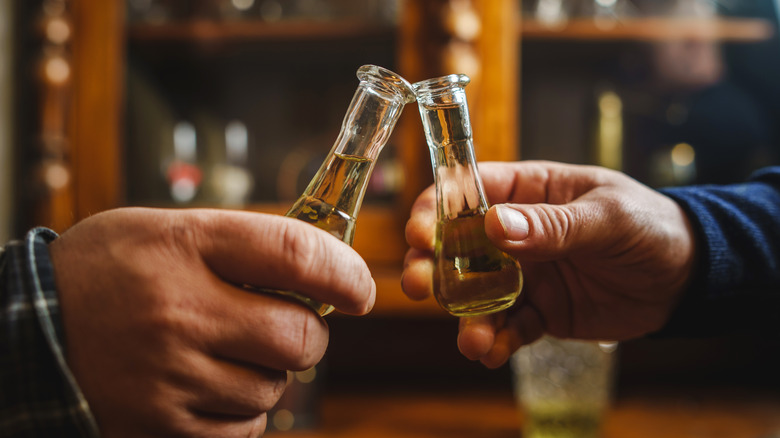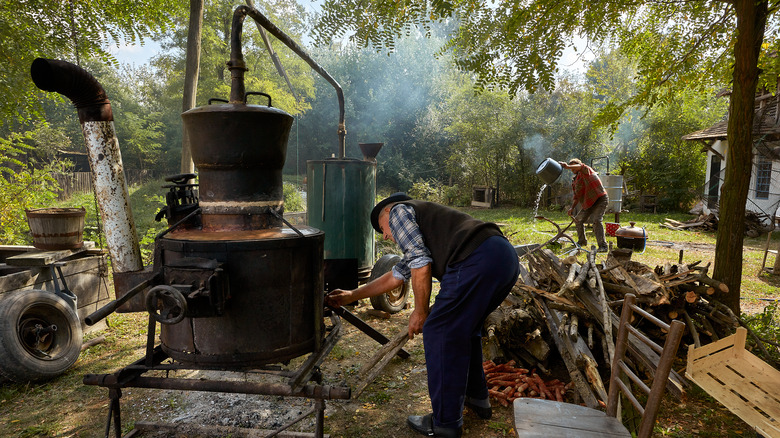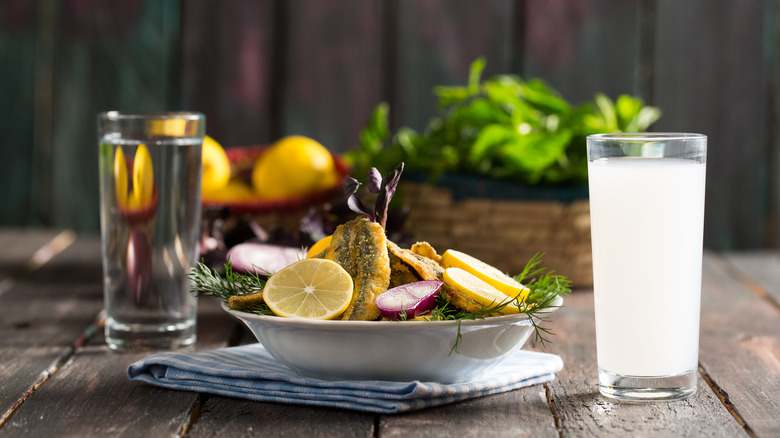The Difference Between Raki And Rakija
Dining along the Mediterranean is a gastronomical experience of a lifetime. From Greek moussaka to Croatian octopus peka to delicious grilled Turkish kebabs, it's fair to say there's an endless array of bites to sample. To accompany the culinary delights, there's a wide range of intoxicating beverages. Croatian wine is increasingly in the spotlight, but how about something stronger to sip on — a glass of rakija? Or raki? Wait, perhaps ouzo is the move? Like with food, the assortment of Medditerreanan liquors is extensive. With some types born from centuries of cultural intermingling, and others from monks distilling in monasteries (via Tales of the Cocktail), it's safe to say it can get complicated.
Adding to the mixed-up medley, the naming of unrelated spirits overlaps. The Albanians drink raki made with different fruit (per Ecotour Albania), while in Greece, raki is manufactured exclusively from fresh grapes. Cross the border to Turkey, raki is still a grape-based distillate but flavored with anise, via Greek Boston. What's getting poured into the glass may be dependably delicious — but how is it differentiated? Let's untangle these spirits.
Rakija is a fruit-based Eastern European spirit
Rakija, a strong fruit-based spirit, is consumed in Croatia, Serbia, Montenegro, and more, explains Expat in Croatia. Distilled from a variety of fruits, it's typically clear, but additions like herbs post-distillation can add a slight tint. Known for its regional distinctions and dazzling variety, there are more than 20 cataloged types in Croatia alone. This fruit brandy, which can also be spelled rakia, is made for sipping — consumed straight rather than mixed or on ice.
Ranging from 40-60% alcohol, the specific type is delineated by the type of fruit. For example, šljivovica, one of the most popular types, is made from plums, notes Atlas Obscura. An unregulated moonshine for most of its existence, rakija is still frequently distilled in homemade, non-licensed operations.
While the first legal distillery only opened in Serbia in 1985, it doesn't mean the spirit isn't established, notes Food & Wine. Encompassing a wide range of flavors, distillation methods, and aged for various durations, rakja is delicious and versatile. Just don't expect it to contain anise seed or turn cloudy when poured on ice — that's Turkish raki.
Raki is a Turkish grape-based distillate similar to ouzo
Raki, also known as Lion's Milk, is distilled exclusively from grapes, usually leftover from wine production, according to Doya. Flavored with anise, the spirit packs a high-proof punch around the same intensity as rakija — ranging from 40-50% alcohol (via Wine Anatolia). Similar to ouzo, raki is typically poured over water and ice, yielding a tall glass of milky-colored liquid. An accompaniment to food, especially a spread of mezze, it's a potent yet refreshing spirit sipped on between bites.
In contrast to the myriad of rakija micro-producers, raki production was centralized following World War II. Operated by Tekel, the government-operated liquor and tobacco company monopolized all production for nearly 60 years, notes Yeni Raki. In 2004, the industry privatized, once again opening commercial distillation to multiple producers. According to Made in Turkey Tours, there are now around 20 raki brands available in Turkey, with the style ever-expanding. Regardless, there's still much less variation than with rakija — and the flavor profile is more consistent.
With Turks ruling over the Balkan region for over five centuries (via Britannica), it's no surprise names and techniques intermingled, creating a nomenclature grey area. Such an Ottoman legacy persists specifically in Albania, where locals call their various fruit (not exclusively grape) liquors raki, per Definify. So while rakija and raki exhibit tangible flavor differences, in part, it's also about the country where a glass is poured.


